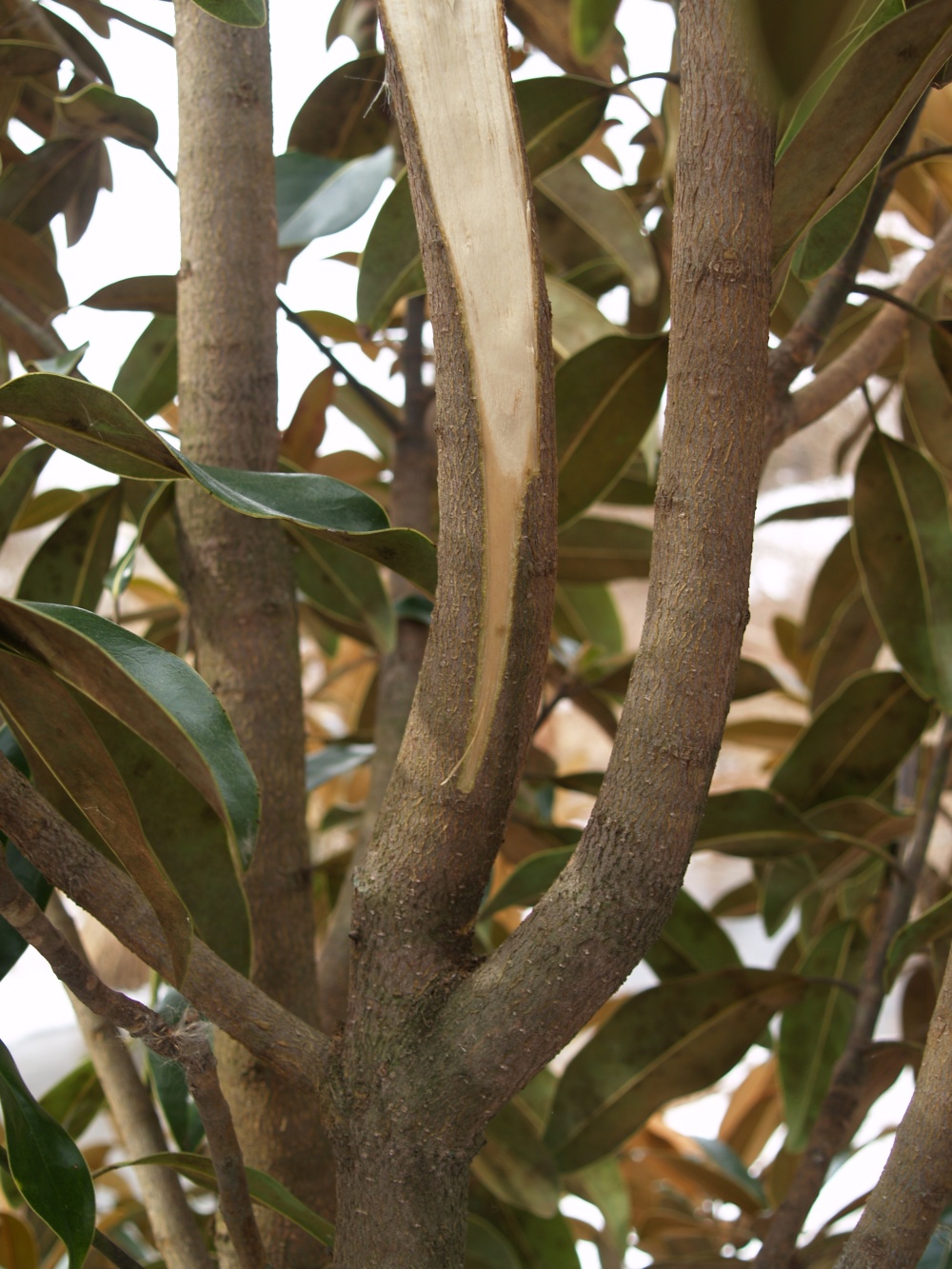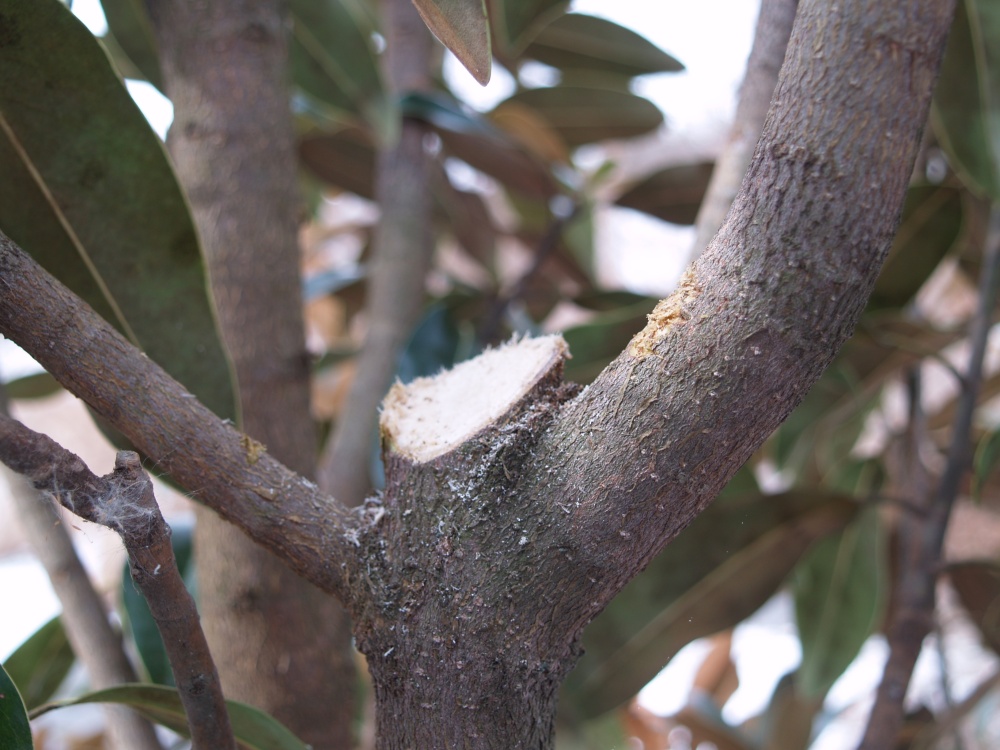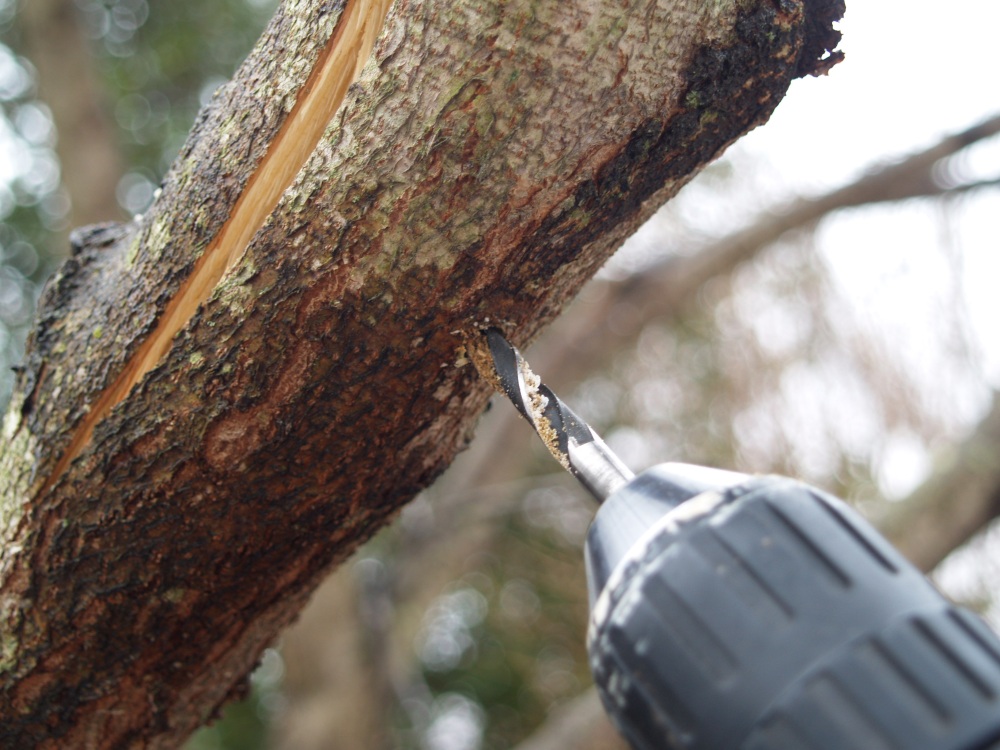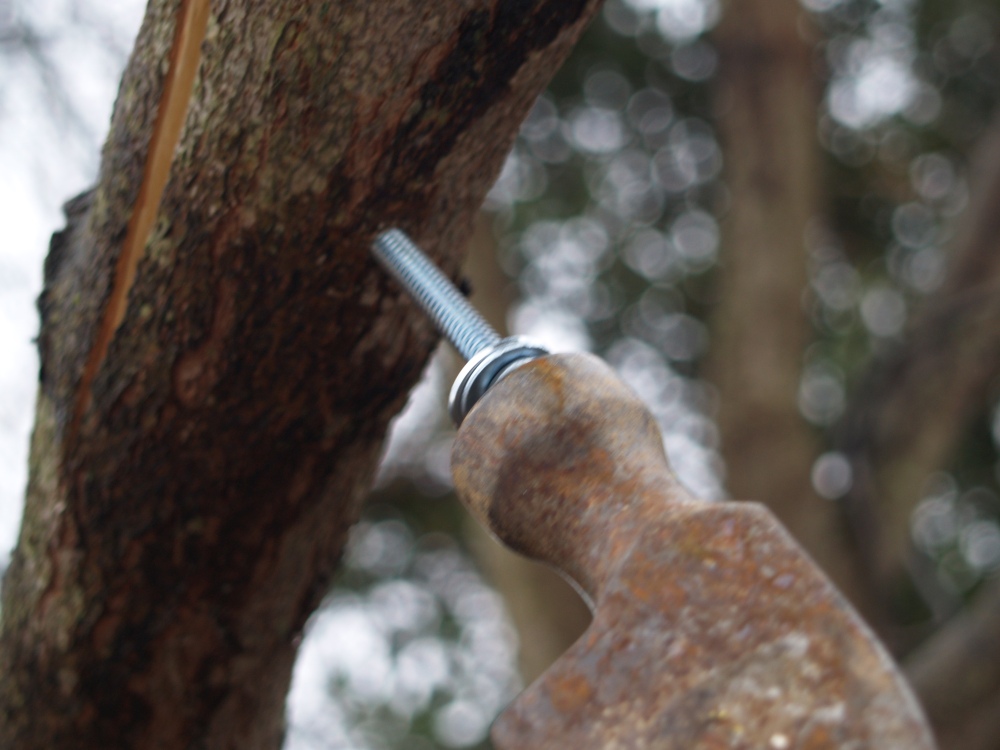In the previous chapter I pruned large branches that were broken in the recent heavy, wet snow. Today will begin with repairing damage to evergreens, and then will address how to save branches that have split, but not broken beyond repair.
Damage to evergreens was less extensive than in the heavy snows of February 2010, but some of the same problems are evident. Further information from early March on pruning and repair of bent and splayed evergreens can be accessed by clicking the links.
There are three evergreen magnolias in the garden, and two were ravaged last year. The third escaped with minor damage, but suffered considerably in the recent storm (above). The central trunk and two major branches were broken so that the parts of the splintered branches that remain must be removed. 
Since the branches of this young magnolia can be reached using only a six foot step ladder, the repairs will be much easier and precise. The limbs of the taller magnolias broken in last year’s snow were removed with a polesaw, with a handle that extends to sixteen feet. I was able to remove the damaged branches, but a stub was left that will be prone to rotting. 
The magnolia’s branches had broken through, with two falling to the ground and the third caught in the uppermost branches and easily removed. The sliver of wood that remained was cut as closely as possible at the junction just above the next lower set of branches (above). Many evergreens do not have lateral growth buds, so when a branch is broken it must be pruned back to the next set of branches, or to the trunk. Since access was limited the pruning cut is not as clean as I would prefer, but it should heal quickly.
In the short term, the missing branches will upset the magnolia’s form, but the tree will react as if the branches were pruned, which will result in more side growth. Eventually, one of the branches will develop a more upright habit and take over as the central trunk, and in five years it is likely that the injury will not be evident.
Repairing a split branch
The branch on this redbud did not break through, but the injury is likely to kill the branch if it is not repaired. In the best case, I would take the weight off the injured area by tying the branch to another higher in the tree, but there are no taller branches on the redbud, so I’ll do the best I can.
First, I will drill a hole through the branch with a one-quarter inch drill bit to match the same size bolt (above).
I’ll place a washer on the bolt, and tap it through the hole with a hammer (above). Then, another washer will be placed on the other side of the bolt, and the nut will be hand tightened. I’ll use a box end wrench to tighten the bolt until it draws the split together as close as possible (below).
I will cut the excess from the bolt, only so that it is not seen. The split will mend itself in the next year, and the bolt will remain in place as the tree grows around it.
There remains considerable damage to repair. The upright growing ‘Seriyu’ Japanese maples lost many branches, so I will climb a ladder to prune the remaining stubs as soon as the weather gets a bit warmer. I fear that the broken top of a ‘Sekkan Sugi’ cryptomeria is beyond the reach of my sixteen foot polesaw, and the tree will be too difficult to climb, so the damaged trunk might be left in place. It is likely that the tree will heal itself, but the top will look awkward for a time.
Some branches of nandinas and boxwoods remain bent to the ground in the frozen snow, but most branches that have been freed as the snow melts have sprung back to their original position. I expect that there will be little damage to shrubs and small evergreens beyond a few broken branches.
Can I get a red cedar to stand straight again after being bent over by the weigth of the snow? I had some success with tying a rope around a few last year and pulling hard to get them to straighten up but ended up having to cut a few cedars down. Thanks.
An arborvitae in my garden that was bent severely a year ago suffered similar injury in the snow a few weeks ago, but I brushed much of the snow off it and it has returned nearly to its original shape. With much less snow this winter, and quicker melting, I think that many evergreens will bounce back without having to do anything to help.
For those that stubbornly remain bent you can pull in the opposite direction, and often this will remedy a minor bend. If this fails, and the cedar is not too large, you might be able pull it upright, then drive a stake and tie the rope so that the trunk is held in the upright position. Two stakes and ropes are more effective than one, and I would expect that the trunk will retain the upright form after a few months.
Thank you. The 2 red cedars have straightened up a bit. I will see what happens over the next few weeks and then decide whether to give them an assist or not.
I have the same situation with my young magnolia- the center branch was completely severed but the two side branches are in good shape. Should I paint the scar with anything to help prevent rot?
If possible it is best to prune damaged branches back as close as possible to the larger branch or trunk without cutting into the branch collar, which is a slightly enlarged area. This will mean that there is a slight bump whenever a branch is removed, but in the branch collar are cells that will speed healing. It is not recommended to apply any tree paint or other sealants to a wound. These can slow or prevent the wound from healing.
Hi- we have a beautiful magnolia that just suffered some serious trauma in a recent snowstorm where there was a lot of strong winds and heavy, wet snow fall. Two large branches/limbs that had a significant amount of (what appeared to be) dead branches snapped and then cracked off. The break caused the bark to tear and now there is a lot of wood showing where the unclean crack happened. Is there anything that we can do to help salvage the tree? Can we seal the wounds somehow and help the tree move on? Thanks!
Any excess loose bark should be trimmed, but otherwise the exposed area should not be treated. Sealing paints are no longer recommended. Several years ago I had extensive damage to several magnolias in a 32 inch snowfall. One magnolia had the top three-quarters broken (15 feet), and then it broke again the next year. Others had multiple broken branches which were pruned. Magnolias are not delicate trees, so they should recover quickly.
Thank you- that is reassuring to hear since we love the tree so much and don’t want to ever have to cut it down!!